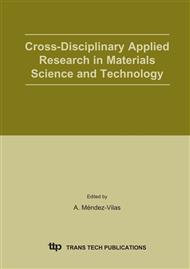p.411
p.417
p.423
p.429
p.437
p.445
p.449
p.453
p.457
Analysis of Dielectric Relaxation Parameters in the Range of Glass Transition
Abstract:
The apparent activation energy W, the temperature Ta at which the molecular movement is assumed frozen (the relaxation time is infinitely large) and the preexponential factor t0 were determined for Nylon 11 using the data obtained by fractional polarization thermally stimulated discharge current technique. The aim was to investigate the temperature dependence of the relaxation time in the range of the glass transition temperature. An experimental thermogram can be analyzed equally well using the Vogel-Fulcher-Tammann-Hess relationship or the Arrhenius equation. Experimental results and simulations, for nearby peaks, demonstrate that the relaxation time at peak temperature changes from about 100 to 500 s revealing a very narrow distribution in relaxation times. On contrary, W and especially t0 varies in large limits and the values for t0 are in many situations physically meaningless. It was found that the temperature at which the molecular movement can be assumed frozen for electric effects is about 150 K below the glass transition temperature in Nylon 11. A small change in W (in the limit ± kTm which represents the minimum uncertainty interval in W) induces a change in t0 of about two decades, indicating (i) that any analysis assuming t0 constant should be avoided and (ii) the selectivity limit of the method.
Info:
Periodical:
Pages:
437-444
Citation:
Online since:
March 2005
Authors:
Price:
Сopyright:
© 2005 Trans Tech Publications Ltd. All Rights Reserved
Share:
Citation:


